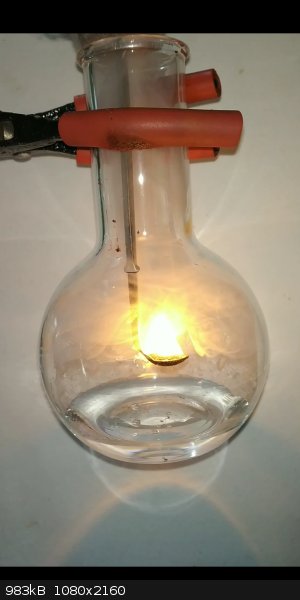
vibbzlab - 12-11-2019 at 17:45
I tried to create Disodium hydrogen phosphate by burning red phosphorus in concentrated caustic soda solution taken in a flask and mixed up the
vapours in the solution by shaking the glassware. Would it have produced the salt ? Any ideas on thar?

Loptr - 12-11-2019 at 17:47
Sounds like a waste if red phosphorus to me, but that's only because it isnt readily available where I am located.
vibbzlab - 12-11-2019 at 17:48
It's available here and I did it for the sake of proving theory
Metacelsus - 12-11-2019 at 20:08
Yes it should produce the salt (the initial product would be P2O5 which would then dissolve).
But it's about as useful as making NaCl from Na and Cl2.
wg48temp9 - 12-11-2019 at 20:19
White P and probably red P react with sodium hydroxide to form phosphine and sodium hypophosphite.
To clarify my comment when you burn P in a flask you tend to get some condensed phosphorus vapor on the walls of the flask and probably in the NaOH.
[Edited on 11/13/2019 by wg48temp9]
vibbzlab - 12-11-2019 at 20:23
So is there any special test to know whether I made Disodium hydrogen phosphate or not?
draculic acid69 - 13-11-2019 at 06:46
Sodium hypophosphite +HCL will give hypophosphorus acid which if reacted with iodine will exothermically react to form HI whereas phosphoric acid
won't react with iodine.
[Edited on 13-11-2019 by draculic acid69]
vibbzlab - 13-11-2019 at 08:53
Oh ok thanks for that
mayko - 13-11-2019 at 10:17
The degree of protonation of phosphate is pH dependent; that's why it's often used in buffers. If your solution is still strongly basic, you have
trisodium phosphate (Na3PO4), not disodium hydrogen phosphate (Na2HPO4).
AJKOER - 21-11-2019 at 16:53
For safety concerns, with an aqueous mix of NaOH+P, I would avoid any incidental contact with Aluminum or its alloy, or Mg or other very
electropositive metals, per Hodges comment at https://www.sciencemadness.org/whisper/viewthread.php?tid=15... , and find that you manage to also stumble into something serious. As a possible
source, see https://www.citycollegiate.com/atomichydrogen.htm . Also, commentary in Bretherick, Volume 1, page 23-24, to quote:
"A student mixed aluminium foil and drain cleaner in a soft drink bottle, which started emitting gas. Another student carried the bottle outside and
was claimed to have been overcome by the toxic fumes [1]. Most drain cleaners are alkalis, so that aluminium will dissolve to produce hydrogen. The
bleach that it is is suggested may have been present will produce no toxic fumes in alkali, and one would be surprised to find arsenic or antimony
compounds present. If the collapse was not purely hysterical, the remaining, though remote, possibility would be phosphine. The soft drink the bottle
had contained was one of the many perhaps best described as impure dilute phosphoric acid [2]. "
A related comment attributing the formation of gases like arsine and stibine from nascent hydrogen at https://pubs.acs.org/doi/pdf/10.1021/ed011p308.
Education on nascent hydrogen interaction is important so as to avoid toxic gases that may be inadvertently and unexpectedly create in significant
amounts.
---------------------------------------------------
Having a significant oxygen presence at a temperature over 25 C may be interesting, but I would still avoid (see https://chemiday.com/en/reaction/3-1-0-807 ) owing to a fire/explosion hazard per page 1,665 in Bretherick.
A good experiment to perform is likely described here: https://chemiday.com/en/reaction/3-1-0-9380 .
[Edited on 22-11-2019 by AJKOER]
